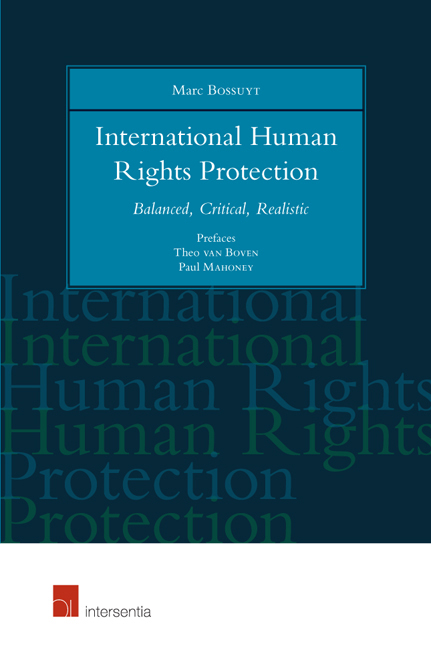Book contents
- Frontmatter
- Dedication
- Preface: A Lifetime of Fidelity and Participation
- Preface: A Penetrating and Salutary Analysis of the European System of Human Rights Protection
- Introduction
- Contents
- Epigraph
- PART ONE International Protection of Human Rights in General
- A The Normative Framework
- B The Institutional Framework
- PART TWO Specific Human Rights Protection
- Annex: At the Crossroads of Law and Politics
- Bibliographies
- About the Author
B - The Institutional Framework
from PART ONE - International Protection of Human Rights in General
Published online by Cambridge University Press: 25 September 2018
- Frontmatter
- Dedication
- Preface: A Lifetime of Fidelity and Participation
- Preface: A Penetrating and Salutary Analysis of the European System of Human Rights Protection
- Introduction
- Contents
- Epigraph
- PART ONE International Protection of Human Rights in General
- A The Normative Framework
- B The Institutional Framework
- PART TWO Specific Human Rights Protection
- Annex: At the Crossroads of Law and Politics
- Bibliographies
- About the Author
Summary
Understanding international protection of human rights requires knowledge of the institutional framework in which those norms have been adopted and of the mechanisms set in place to favour respect of those norms. A brief survey will be given of the most important instruments, organs and procedures developed both in the framework of the United Nations and in the framework of regional organisations
In the framework of the United Nations, attention is given, first, to the UN Charter-based organs, in particular the UN Commission on Human Rights and its successor the Human Rights Council, including the confidential procedure for the examination of communications and the special procedures (country oriented and thematic) (Chapter V), and, second, to the treaty-based UN organs established by the International Covenants on Human Rights, by the conventions prohibiting discrimination, in particular discrimination based on race and against women, and by other conventions such as those against torture and enforced disappearance and on the rights of the child, of migrant workers and of persons with disabilities (Chapter VI).
At the regional level (Chapter VII) attention is given to the protection of human rights in the framework of the Council of Europe, more particularly by the European Convention on Human Rights (1950) and the European Social Charter (1961), revised in 1996; of the Organisation of American States, by the American Convention on Human Rights (1978); and of the Organisation of the African Union, by the African Charter on Human and Peoples’ Rights (1981).
Until the 20th century, the protection of human rights was, with the exception of slavery, considered to belong to the domestic jurisdiction of each State. Before the end of the Second World War, the only precedents for international protection of human rights were the minimum standard for foreigners, the humanitarian intervention and the protection of minorities in the framework of the League of Nations. The breakthrough was the adoption at San Francisco on 26 June 1945 of the Charter of the Organisation of the United Nations, which contains a number of provisions referring to human rights.
- Type
- Chapter
- Information
- International Human Rights ProtectionBalanced, Critical, Realistic, pp. 57 - 58Publisher: IntersentiaPrint publication year: 2016



